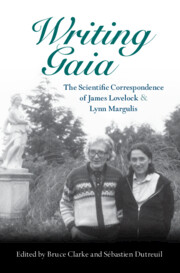Book contents
- Writing Gaia: The Scientific Correspondence of James Lovelock and Lynn Margulis
- Reviews
- Writing Gaia: The Scientific Correspondence of James Lovelock and Lynn Margulis
- Copyright page
- Epigraph
- Table of Contents
- Figures
- Contributors
- Foreword by James Lovelock
- Preface
- Acknowledgements
- Introduction
- Part I 1970–1972
- 1970
- 1971
- 1972
- Part II 1973–1979
- Part III 1980–1991
- Part IV 1992–2007
- Part V Commentaries on Lovelock and Margulis
- Glossary of Names
- Glossary of Terms
- Bibliography
- Index
1972
from Part I - 1970–1972
Published online by Cambridge University Press: 28 July 2022
- Writing Gaia: The Scientific Correspondence of James Lovelock and Lynn Margulis
- Reviews
- Writing Gaia: The Scientific Correspondence of James Lovelock and Lynn Margulis
- Copyright page
- Epigraph
- Table of Contents
- Figures
- Contributors
- Foreword by James Lovelock
- Preface
- Acknowledgements
- Introduction
- Part I 1970–1972
- 1970
- 1971
- 1972
- Part II 1973–1979
- Part III 1980–1991
- Part IV 1992–2007
- Part V Commentaries on Lovelock and Margulis
- Glossary of Names
- Glossary of Terms
- Bibliography
- Index
Summary
It appears that Lovelock and Margulis determined during their first in-person meeting in December 1971 that they had “something to say” about, as Lovelock puts it in Letter 11, “the notion of a living planet.” Here again is the “planetary ecosystem” of Lovelock and Giffin 1969, for which the atmosphere is not merely an abiological medium but rather one that is biologically maintained. Lovelock now informed Margulis that his neighborhood acquaintance in the south of England, the prominent British novelist William Golding, suggested “Gaia” as a name for the living planet so described. Setting to work on the first co-authored essay with Margulis, Lovelock began to transmit the finer details of the geochemistry informing his hypothesis. Letters 12 and 13 confirm that Margulis was currently tasked to transform Lovelock’s data into a collaborative prose narrative, and that she was quickly sending him drafts of her work. It would seem that, under his guidance, she was doing the major part of the composition of the text. Letter 14 documents the event of Margulis’s taking full grasp of the notion of Gaia as a biological cybernetic system. Gaia is described as a system built up from negative-feedback cycles that control molecular variables in the environment. In this instance, methanogenic microbes are seen as being successively turned on and off by their own environmental consequences, forming a biogeochemical cycle that “homeostats,” or self-regulates, the level of atmospheric methane.55
- Type
- Chapter
- Information
- Publisher: Cambridge University PressPrint publication year: 2022

